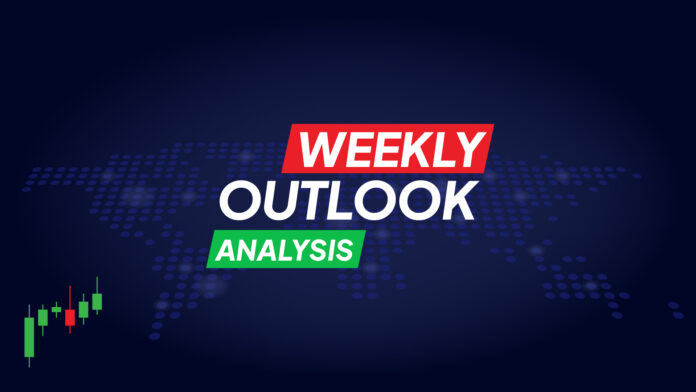Key points to watch out for:
- PCE inflation to focus the Fed’s attention this week
- Eurozone inflation data will prove decisive for ECB rate cut expectations
- Australian and Tokyo CPI and Canadian GDP on tap for the week
Will the ECP’s Moderate Inflation Expectations Fall Short?
The European Central Bank’s moderate inflation expectations might not be met, raising concerns among investors. As the Federal Reserve prepares for its long-awaited moderate turn, markets are anticipating the first rate cut of this cycle at the September 17-18 meeting. However, the Fed remains data-dependent, and the updated dot plot accompanying the September decision means that the rate path is far from set in stone. The more hawkish members of the FOMC continue to assess upside risks to inflation. Should the Fed cut rates by as much as 100 basis points, as the markets predict, new data will need to surprise to the downside significantly.
Consequently, the Personal Income and Expenditures report on Friday, August 30, which includes consumer figures and the Personal Consumption Expenditures (PCE) price index, will attract significant attention. The underlying PCE price index remained steady at 2.6% year-on-year in June and is expected to continue this trend in July. While the overall PCE figure is also predicted to hold at 2.5% year-on-year, personal consumption is believed to have increased by a healthy 0.5% month-on-month in July.
This increase might not alleviate recession fears but could dampen hopes for an aggressive rate cut. Meanwhile, the estimated 0.2% month-on-month increase in personal income could help counter concerns that U.S. consumers are close to splurging again. The U.S. dollar is on track for its fifth consecutive weekly loss against a basket of currencies, making it vulnerable to a rally if the report is more bullish than expected.
Treasury Auction and Nvidia Results in the Spotlight
Before the PCE data, July durable goods orders will be released on Monday, August 26, followed by August consumer confidence on Tuesday, August 27. The second estimate of second-quarter GDP growth will be released on Thursday, August 29, and the Chicago PMI on Friday, August 30. This week’s Treasury auctions may also spur volatility in the fixed-income market as trading volumes recover from the summer lull. Equity markets will closely analyze Nvidia’s latest results, set to be released on Wednesday, August 28.
Last Eurozone CPI Report Ahead of Next ECB Meeting
This month, the euro has surged against the U.S. dollar, surpassing the $1.11 level, a figure not seen since December. Despite strong expectations that the European Central Bank will lower interest rates again in September, there remains a small but significant risk that ECB policymakers may not be convinced to implement another cut. The preliminary August CPI forecast on Friday, August 30, will be crucial for determining if further easing will be approved in September.
Eurozone headline inflation is expected to moderate from 2.6% year-on-year in July to 2.3% in August, bringing it closer to the ECB’s 2% target. The core inflation rate is expected to fall slightly to 2.8% year-on-year. Any disappointment in these inflation figures could further strengthen the euro against the U.S. dollar, although market consensus on a rate cut in September is unlikely to change.
Tokyo CPI Will Be Decisive for the Bank of Japan
The yen, or more specifically the Bank of Japan, is partly responsible for the dollar’s recent woes. The realization that Japan’s years of ultra-loose monetary policy are ending resonated with investors after the BoJ simultaneously raised rates and announced a gradual halving of its asset purchases at its July meeting. There is a considerable chance that the BoJ will raise rates for a third time by the end of 2024.
Governor Ueda has hinted at further rate hikes if the economy and inflation remain on track, despite concerns about current market instability. The Tokyo CPI data on Friday, August 30, will be key, as it is viewed as a precursor to the national figures released later in the day. Other indicators, such as preliminary July industrial production, retail sales, and the unemployment rate, will also be released on August 30.
The Reserve Bank of Australia Awaits Further Developments on Inflation
In Australia, inflation will be a major focus this week. Monthly data, to be released on Wednesday, August 28, will be closely watched amid concerns that inflation might continue to stagnate. After rising in previous months, the annual CPI rate fell to 3.8% in June. However, policymakers at the Reserve Bank of Australia want to see further declines before considering abandoning their tightening stance.
If no progress is made in July, it is likely that the RBA will continue to unwind rates this year, which would be positive news for the Australian dollar, which has gained nearly 3% against the U.S. dollar in August. However, second-quarter construction data due on Wednesday, August 28, and capital spending data due on Thursday, August 29, could pose some downside risks if they fall short of estimates.
Will Canada’s CPI Be Relevant to BoC Rate Cut Bets?
The Bank of Canada is among the central banks leading the rate-cut race. Investors have priced in a more than 90% likelihood of another 25 basis point cut in September, as Canadian inflation has aligned with estimates. However, stronger-than-expected economic growth could prompt policymakers to skip a meeting, turning attention to second-quarter GDP figures on Friday, August 30. A day earlier, on Thursday, August 29, June wage growth figures may also impact the Canadian dollar.



